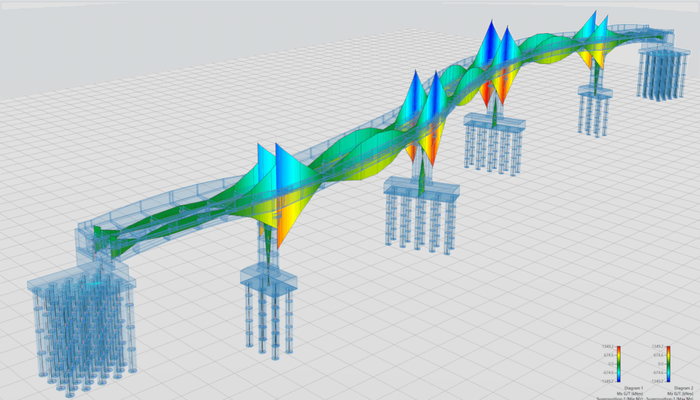How Can an Infrastructure Engineer Benefit from BIM

Table of Contents
The infrastructure of any city largely encompasses roads, bridges, electric grids, water systems, and networks that are foundational for the well-functioning of its neighborhoods, buildings, and facilities. The upcoming digital technology of BIM for Infrastructure has eased the work for infrastructure engineers. It offers various benefits, such as better collaboration, coordination, simulations, and clash detection. In this blog, we will explore the roles and responsibilities of infrastructure engineers and the specific benefits of BIM for Infrastructure engineers in enhancing their work.
Who is an Infrastructure Engineer?

Infrastructure engineers are responsible for the design and construction of public works projects. They work on large-scale projects such as highways, bridges, dams, airports, water treatment plants, sewage systems, and other structures. He or she brings together many skills and services, including geotechnics, water engineering, bridge design, tunnels, site development, rail, waste, and highway design.
Scope of Work of an Infrastructure Engineer
Let us look at the roles and responsibilities of an infrastructure engineer:
- Improving the existing infrastructure or creating new infrastructure where none currently exists
- Developing budgets for proposed projects
- Analyzing operational problems, such as power outages and water leakage, and developing solutions for them
- Conducting studies to determine the feasibility of proposed projects
- Evaluating the safety of structures to determine if they need repair or reconstruction
- Evaluating the efficiency of existing systems and developing improvement plans based on the findings
- Supervising the construction process from end-to-end to ensure that the project meets the set budget and timelines
Average Salary of an Infrastructure Engineer
According to Glassdoor, the average base pay of an infrastructure engineer in India is Rs. 8,00,063. However, the salary may vary depending on several factors like education, experience, location, and type of employer.
Applications of BIM in Infrastructure Engineering
BIM presents a plethora of opportunities for infrastructure engineers to take a leap in construction process, material selection, costing and application, and ensuring economic efficiency throughout infrastructure project lifecycles. Let us look at some of the applications of BIM for infrastructure engineers.
1. Visualisation

There is an ongoing transition from basic 2D drawings towards the use of 3D and object-based BIM models. These information-heavy models can be utilized in many ways, from the feasibility study to the maintenance of the structure. Let’s see how BIM helps with better visualization of infrastructure projects:
Capturing Existing Site Conditions: With BIM, infrastructure engineers can easily aggregate large amounts of existing data, including reality capture data, 2D CAD, raster data, and GIS (Geographic Information System) data, to enhance the accuracy of the 3D model of existing sites.
Conceptual Visualization: Using an intelligent 3D project model, civil engineers can rapidly produce conceptual designs of their infrastructure and evaluate different options in preliminary design phases.
2. Detailed Designing

Infrastructural engineers can use advanced tools such as component roads, cross-section views, and superelevation for more advanced road design. BIM tools can be used for transportation projects to effectively design roadway alignments and easily add turn lanes, intersections, and overpasses. Specialized analysis tools are used to check parking lot spacing and road styling to help determine lot counts for better preliminary subdivision layout concepts. BIM also facilitates better planning, design, and structural analysis of bridge structures with the help of expanded bridge design features like component-based bridges and line girder analysis to enhance accuracy and precision.
3. Improved Collaboration

BIM enables project teams to work on the same model. This eliminates the need for separate drawings and reduces the risk of errors and inconsistencies. This can help streamline the design process and reduce the time and cost required for design changes. BIM models can be shared and accessed by all team members, regardless of their location. This allows for real-time collaboration and decision-making, which can help keep the project on track and within budget.
4. Clash Detection

By simulating the project in a virtual environment, BIM can identify clashes between different systems, such as plumbing and electrical, and highlight them for resolution before construction begins. This can help prevent costly issues during construction and improve the overall quality of the project. Navisworks is the best BIM software on the market, useful for clash detection and clash report generation.
Popular BIM Software Used by Infrastructure Engineers
BIM is an intelligent 3D modelling software used to plan, design, construct, collaborate, and communicate conveniently. It helps keep designers, engineers, managers/planners, and various stakeholders on the same page. As BIM is becoming increasingly popular, the market is flooded with several BIM software for infrastructure engineers’ disposal. By retaining a shared resource of project data, BIM helps keep designers, managers, and stakeholders on the same page. Here is the list of the top BIM Softwares for 2023 and beyond.
1. Revit
While commonly used for architectural projects, Revit can also be used for infrastructure projects. The Revit software allows teams to create a 3D model of the infrastructure project, which can be used to visualize and simulate the project before construction begins. Revit can also facilitate collaboration between team members and stakeholders, improving communication and reducing errors.
2. Tekla Structures
Tekla Structures software is used in the construction industry for details of steel and concrete, precast, and in-situ casting. The software allows users to create and manage 3D architectural models in concrete or steel and guides them through the process.
3. Site3D
A full-fledged 3D civil engineering design software, Site3D is developed with intelligent BIM objects. Site3D is capable of handling both complex road networks with varying widths as well as major highways, link roads, and bypasses.
4. Navisworks
Used primarily in the construction industry to complement 3D design packages (such as Revit, AutoCAD, and MicroStation), Autodesk Navisworks allows users to open and combine 3D models, navigate around them in real-time and review the model using a set of tools including comments, redlining viewpoints, and measurements.
Benefits of BIM in Infrastructure Engineering Careers
BIM has lately emerged as a transformative technology in the field of infrastructure engineering. BIM-skilled engineers earn 40% more than the industry average. This is because BIM skills are in high demand but in short supply. Here are a few key benefits of BIM in infrastructure engineering careers:
- Enhanced Collaboration: BIM enhances collaboration and communication among multidisciplinary teams, including project planners/managers, architects, engineers, and other stakeholders. This encourages the exchange of ideas and suggestions at every stage, leading to improved outcomes and reduced costly errors.
- Improved Designed Efficiency: With BIM, you can create detailed and 3D models that represent the structures and systems accurately, leading to enhanced design efficiency. Thus, you can visualize the designs better and identify potential clashes or conflicts in the design process itself.
- Risk Mitigation: With BIM, you can detect clashes between different design elements, and prevent errors and reworks during the construction phase. This approach helps improve project timelines and reduce costs.
- Cost Savings: BIM allows for better cost estimation and management. You can integrate cost data into the BIM model and efficiently track costing and analyze budget. BIM also aids in ensuring transparency throughout the project lifecycle.
- Increased Professional Opportunities: Proficiency in BIM software is a skill in demand. Having knowledge of BIM software like Revit, Navisworks, and AutoCAD can enhance your marketability and career advancement prospects.
Thus, BIM in infrastructure engineering careers offer a multitude of benefits, and it only makes sense to equip yourself with BIM skills.
List of BIM Course Suggestions for Infrastructural Engineers
Now that we have established the relevance and importance of BIM for infrastructure engineers, let us look at some BIM course suggestions for infrastructure engineers to get you started.
1. Novatr

Mode: online, part-time
Completion time: 6 months
Novatr offers a BIM Professional Course that features a specialized, career-relevant curriculum designed and delivered by seasoned BIM experts from leading firms. The 6-month offering involves online part-time study and equips learners with a holistic understanding of BIM processes and software knowledge spanning modeling, information management, cloud collaboration, presentation, clash detection, and visual programming. The course allows students to learn from AEC professionals leading BIM at top-tier firms worldwide and work on a live, RIBA-structured capstone project to practice their skills.
2. BIM Labs

Mode: Offline
Completion Time: 240 hours - 850 hours
BIM Labs offer aspiring professionals a platform and the tools to efficiently plan, design, construct, and manage buildings and infrastructure. They have an offline training center in Kerala. BIMLabs also offers placement opportunities after the completion of the course.
3. TechnoStruct Academy

Mode: Online and E-Live Classes, Classroom Training in Hyderabad and New Delhi
Completion Time: 8 months (for the BIM-ready+ course)
TechnoStruct Academy provides online training courses to prepare in the fields of BIM, AutoCAD, Revit, and NavisWorks. TSA is the training division of the US-based engineering and technology BIM firm TechnoStruct LLC.
Conclusion
From helping with connected workflows to improving the outcomes of the infrastructure projects, there are several benefits of BIM for infrastructure engineers. BIM is being widely used in the infrastructure projects, and therefore, it is in high-demand in the market. Thus, we would like to conclude by saying that it only makes sense for you to enrol yourself for the online BIM courses for infrastructure engineers.
So, are you interested to learn more about BIM and take your career to the next level? Go to our Resources page today to find more insights on these topics and more.

 Thanks for connecting!
Thanks for connecting!



.png)


-1.png)




